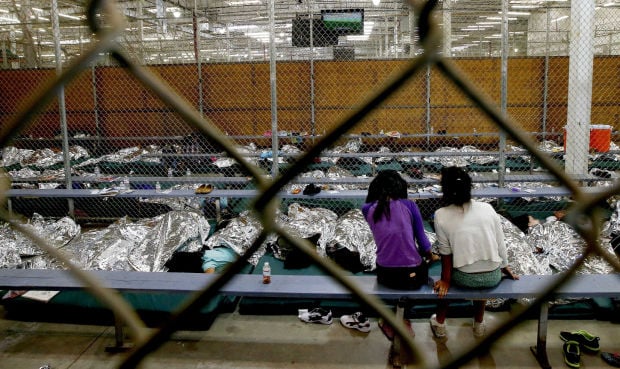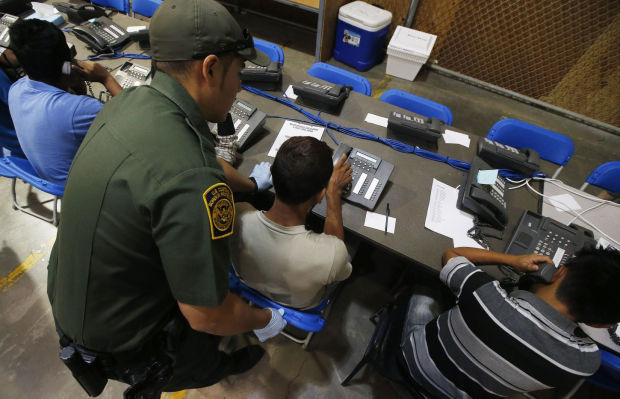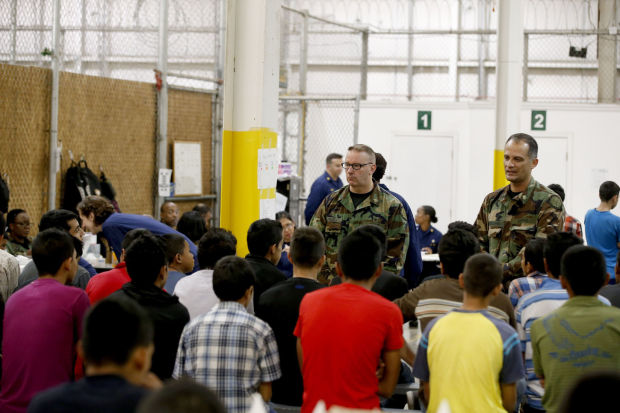NOGALES, Ariz. — A little boy, no older than 8, pressed his forehead against the chain-link fence, crying, before a female Border Patrol agent stopped to ask what was wrong.
An older boy smiled and waved as a group of reporters walked by the intake area, where the concrete floor was hard to see because of all of the small green mattresses lying next to one another.
The media were allowed Wednesday inside the Nogales Placement Center on a restricted tour for the first time since it opened more than two weeks ago. Interaction with the children or staff was not allowed, to protect the identities of the children. Follow-up questions had to be sent via email, and few were answered by deadline.
There are currently 900 children, most from Central America, waiting to be sent to a shelter where officials will work to reunite them with their relatives across the country while their cases are pending.
The federal government is grappling with a sudden surge of children crossing the border without parents. More than 47,000 have been detained so far this fiscal year, and there are no shelters available.
The Nogales center — a building larger than two football fields — is a former warehouse the Border Patrol turned into a processing center for Mexican nationals in the early 2000s. It was not designed to hold children.
But in the beginning of June, agents started to transfer to Nogales some of the children being apprehended in South Texas because stations there were already overcrowded. Some of the children have been there for more than a week.
In the last two weeks, conditions have improved for the children, said Lidwina Magarín, deputy foreign minister for Salvadorans living abroad, but there are still improvements to be made, especially in some of the centers in Texas.
“We are grateful to the government,” she told reporters after she toured the facility. “But we ask that they don’t separate siblings, and keep mothers together with their children.”
In Nogales, the children now have a tent outside where they play several times a week with hula hoops and balls. Some of the agents even join them in a game of basketball and soccer. Their cheers and claps were drowned out by the sound of a drill as a safety fence was installed around the recreation area.
Inside, many of the children and youths appeared sad — either staring into space or covering themselves with the heat-reflective blankets that look like aluminum foil. A young girl with a pink shirt lay on her stomach, crying with her head bent over a white teddy bear as another girl tried to comfort her.
The agents are doing the best they can, said Juanita Molina, executive director of the local Border Action Network, who has toured the center, but they are ill-equipped to deal with the kids’ emotional needs.
The children, she said, are either "super involved or super withdrawn."
There was a 9-year-old who immediately pushed her way when Molina arrived and started to report on everyone around her.
"This girl was crying in the park because she was afraid she wouldn't see her mother again," and "this other girl fell down and started crying but then she stopped," Molina said.
"This was a beautiful, cheerful, smart child," she said. "But her eyes said she knew things she shouldn’t know."
The center is divided into sections by 10-foot-tall chain-link fences with razor wire on the top, which officials said was there before the youths arrived. At the entrance is a processing area where about eight officers identify the children being brought in.
The children are then given a health screening, time to take a shower in one of five trailers with 60 shower heads parked outside the warehouse, and are handed a uniform: navy blue gym shorts and a white T-shirt.
They are then placed in one of nine holding spaces, divided by age and gender. Teen mothers are held separately with their infants. Each area has portable bathrooms and sinks with drinking fountains. In one, for older boys, there was a large TV showing the World Cup.
There’s also the smell, a sharp sting of stale sweat and dirty clothes. While the building is not hot, the swamp coolers can barely keep up.
Girls, some of them pregnant, could be seen making their way to one of 40 telephones available to them to contact their families. A Guatemalan government official said a baby was born last week to a 17-year-old girl.
Even though they get fed six times a day, have stuffed animals and soccer balls to play with and books to read, the youths are still in detention, and the feeling is apparent when you walk in.
They have to get in single file and pass through metal detectors when they go to the makeshift cafeteria. They take turns to use showers or to go outside. And a big banner with the Border Patrol emblem hanging from the rafters is a daily reminder of where they are.






